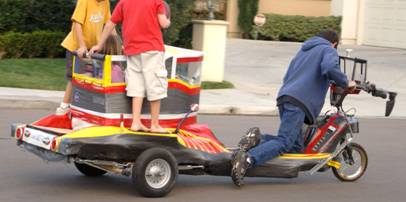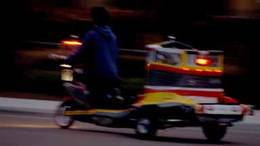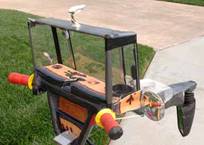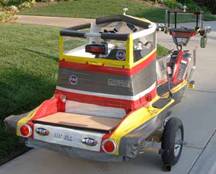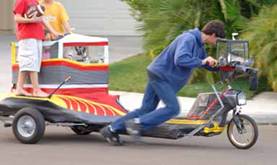
The World’s Largest Human-Powered Scooter
“Thing One” is an amazing, one-of-a-kind vehicle. I discovered it right in my very own suburban San Diego neighborhood.
I first recall seeing it last summer, while I was at one of our neighborhood’s block parties. It was being used to give rides to wide-eyed, appreciative children. Recently I saw it again, as it was cruising past my house. This time I grabbed a camera and a tape recorder, and rushed over to interview the driver.
The creator of this unique vehicle is a young man by the name of Greg Wilson. Greg had the initial idea for a human-powered scooter back in 1998. He was about 12 and in seventh grade. He said that back then go-kart “wars” were popular in our neighborhood, so he decided that he “wanted to build a go-kart to end all go-karts.” With the bobsled races from the winter Olympics fresh in his mind, he attempted to marry a scooter to a go-kart. He thought: “Hey, we’ve got this big green belt that’s half a mile long and it’s shaped like a bobsled track kind of, and its the same steepness and stuff; why not build something that goes super fast and can hit these turns and go flying around with one passenger in the back?”
“We built one and took it up to the park on a day that my parents weren’t home. We took this thing down the hill at about 30 miles an hour. We were all screaming for our lives and holding on! I was driving and (there were) two friends in the back.”
“We thought hey, this is pretty cool, so we kept it for a little while and we added a few little things to it. Finally, on one of the runs, the frame cracked a little in the front. Covered in duct tape, it just barely held on. It was wood. It had a seat belt, car radio, battery, headlight, horn – and a pull brake, with a shoe nailed on it.” The shoe slowed the scooter by rubbing on the ground “and you could use your other foot, if that wasn’t enough!”
“We said okay, now we know that the idea works. Let’s build a really, really nice one. We went back and said what was weak and what wasn’t weak, what worked and what didn’t work. And so we slowly started to find the right parts.”
“We looked around for a scooter frame that was strong enough and we found one. It was a 1988 Raleigh girls push scooter. We took it down to a machine shop and had some extra stuff welded onto it. We had it braced and everything. We took dowels and shoved them up the pipes to make it a little more flexible and a little stronger. We also had some of the clamps beefed up.”
Smooth as opposed to knobby-treaded wheelbarrow tires are used, for two reasons. First is for braking, since the brake is a lever-actuated beam that presses against the rear tires (a spring keeps the beam clear of the tires when braking is not wanted). Smooth tires maximize the contact area.
The second reason is for speed. Greg said that knobby tires are slower than smooth ones. Furthermore, the amount of “wobble” in the tires can be adjusted to help govern speed. Wobbly tires are slower, and the differences can be significant.
Suspension? But of course. This one is of the innovative tennis ball variety, and no expense has been spared here. There are four strategically placed tennis balls per side.
The alignment of the rear axle can be adjusted. As Greg explains it: “Depending on what the hill is we’re going down, we find that if we move one (side) forward versus the other it will work a little better, because maybe the whole hill is skewed to one side or the other.”
“Thing One” has a complex, battery-powered electrical system. A gauge displays remaining battery charge and there is a charger in the trunk.
There are lights, inside and out; a fan in the passenger cabin; a number of switches to control everything; and an audio system – complete with Bose speakers in the dash. “The whole thing has extra wiring built in to it, in case I want to add things – like a CB or something.”
The windshield is formed out of steel bars that have been clamped in a vise and bent to shape. Lexan is epoxied into the frame to create a windshield that is sort of like safety glass.
Speaking of safety, that is not an afterthought on “Thing One.” Because “it’s like a giant scooter” they decided to “put a bus mirror on the front. We made a miniature bus extension and stuck it on.”
It has seat belts “because we figured if it crashed — we weren’t thinking about the driver but we were thinking about the passenger. The driver is me. My insurance is okay, but if the passenger gets hurt, that’s a problem.”
Lots of duct tape is used. “Although most people don’t know it, duct tape is actually fire resistant – meaning that if you light it on fire it will just burn itself out.”
“The original idea for a horn wasn’t loud enough as we were going down the hill – because the wind would drown it out; and also (since) little kids are always shouting, they couldn’t hear it. So, we went down to the swap meet and bought a couple of old car horns and wired those on – because we wanted to get the sound of a small train horn. We bought five horns and settled on two.”
Reinforcing rebar is used across the front, “in case I hit a tree or something.” There is an on-board fire extinguisher, “if you have problems with the battery.”
The passenger cabin “is made out of a variety of things,” including steel tubing, plastic bars, two-by-twos with metal strapping on them, zig-zagged rebar wire for a little more rigidity, duct tape and “insulation stuff – which serves no real purpose except to look nice”. There is a lot of Lexan in the passenger cabin too, for strength.
“Thing One” is potentially very quick. Greg said: “I’ll bet it could hit 100 down a big, fast hill, but I wouldn’t want to drive it in that case. I think it would start falling apart.”
Greg is in college now, where he is studying “sound reinforcement” to design sound systems for commercial installations, like stadiums. He told me that after he makes his money in life, someday he would like to start a company that builds human-powered, scooter-like vehicles for kids. Their structures would include bolted-on plywood panels or two-by-fours, to make it relatively easy for kids to personalize their scooters with their own add-ons – such as upper frames, a radio, windows and more. A website would provide additional ideas. Supplying the basic structure “takes the danger and the guesswork out of building the actual frame. 99% of the time when kids get hurt when they build (a go-kart), the frame falls apart and they go flying. Give them something that’s reliable and safe, and then let them do whatever they want to.”
Drive safely and do join me again next time.

